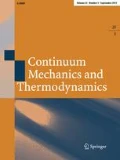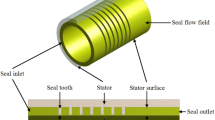Abstract
In gas turbines, high combustion efficiency as well as operational safety are required. Thus, labyrinth seal systems with honeycomb liners are commonly used. In the case of rubbing events in the seal system, the components can be damaged due to cyclic thermal and mechanical loads. Temperature differences occurring at labyrinth seal fins during rubbing events can be determined by considering a single heat source acting periodically on the surface of a rotating cylinder. Existing literature analysing the temperature distribution on rotating cylindrical bodies due to a stationary heat source is reviewed. The temperature distribution on the circumference of a simplified labyrinth seal fin is calculated using an available and easy to implement analytical approach. A finite element model of the simplified labyrinth seal fin is created and the numerical results are compared to the analytical results. The temperature distributions calculated by the analytical and the numerical approaches coincide for low sliding velocities, while there are discrepancies of the calculated maximum temperatures for higher sliding velocities. The use of the analytical approach allows the conservative estimation of the maximum temperatures arising in labyrinth seal fins during rubbing events. At the same time, high calculation costs can be avoided.
Similar content being viewed by others
Abbreviations
- a :
-
Contact half length (m)
- \(c_p\) :
-
Specific heat (\(\frac{\text {J}}{\text {kg}\,\text {K}}\))
- \(\delta \) :
-
Heat penetration depth (m)
- h :
-
Heat transfer coefficient (\(\frac{\text {W}}{\text {m}^\text {2}\,\text {K}}\))
- \(h_{0}\) :
-
Reference heat transfer coefficient (\(\frac{\text {W}}{\text {m}^\text {2}\,\text {K}}\))
- \(h^{*}\) :
-
Dimensionless heat transfer coefficient (–)
- \(\kappa \) :
-
Thermal diffusivity (\(\frac{\text {m}^\text {2}}{\text {s}}\))
- \(\lambda \) :
-
Thermal conductivity (\(\frac{\text {W}}{\text {m}\,\text {K}}\))
- \(\lambda _{0}\) :
-
Reference thermal conductivity (\(\frac{\text {W}}{\text {m}\,\text {K}}\))
- \(\lambda ^{*}\) :
-
Dimensionless thermal conductivity (–)
- Pe :
-
Peclet number (–)
- \(\dot{q}\) :
-
Heat source intensity (\(\frac{\text {W}}{\text {m}^\text {2}}\))
- r :
-
Radius (m)
- \(\rho \) :
-
Density (\(\frac{\text {kg}}{\text {m}^\text {3}}\))
- s :
-
Sliding distance (m)
- T :
-
Temperature (\(^\circ \text {C}\))
- \(T_{\text {max}}\) :
-
Maximum temperature (\(^\circ \text {C}\))
- \(T_{\text {max}}^{\text {analytical}}\) :
-
Maximum temperature (analytical approach) (\(^\circ \text {C}\))
- \(T_{\text {max}}^{\text {2D}}\) :
-
Maximum temperature (two-dimensional model) (\(^\circ \text {C}\))
- \(\theta \) :
-
Spatial function of the temperature profile (–)
- \(u_z\) :
-
Displacement (m)
- v :
-
Circumferential/sliding velocity (\(\frac{\text {m}}{\text {s}}\))
- x :
-
x-coordinate (m)
- \(\xi \) :
-
Dimensionless x-coordinate (–)
- y :
-
y-coordinate (m)
- z :
-
z-coordinate (m)
- \(\zeta \) :
-
Dimensionless z-coordinate (–)
References
Abrams Premium Stahl: Technical data sheet, Premium 1.7225 (UNS G41400). http://www.premium-stahl.de/images/filedownloads/de/datenblaetter/1.7225.pdf (2012). Accessed 1 June 2017
Chupp, R.E., Hendricks, R.C., Lattime, S.B., Steinetz, B.M.: Sealing in Turbomachinery. J. propul. power. 22(2), 313–349 (2006)
Dassault Systèmes Simulia Corporation: Abaqus Manuals. Version 6.13 (2013)
DesRuisseaux, N.R., Zerkle, R.D.: Temperature in semi-infinite and cylindrical bodies subjected to moving heat sources and surface cooling. J. Heat Transf. 92(3), 456–464 (1970)
Deutsche Edelstahlwerke: Technical data sheet, Firmodur 7225/Firmodur 7227 (UNS G41400). https://www.dewstahl.com/fileadmin/files/dewstahl.com/documents/Publikationen/Werkstoffdatenblaetter/Baustahl/1.7225_1.7227_de.pdf (2015). Accessed 1 June 2017
Fischer, F.D., Schreiner, W.E., Werner, E.A., Sun, C.G.: The temperature and stress fields developing in rolls during hot rolling. J. Mater. Process. Technol. 150, 263–269 (2004)
Fischer, F.D., Werner, E.A., Knothe, K.: The surface temperature of a halfplane heated by friction and cooled by convection. ZAMM Z. Angew. Math. Mech. 81(2), 75–81 (2001)
Gecim, B., Winer, W.O.: Steady temperature in a rotating cylinder subject to surface heating and convective cooling. J. Tribol. 106, 120–127 (1984)
Kennedy, F.E.: Frictional heating and contact temperatures. Mod. Tribol. Handb. 1, 235–259 (2001)
Kennedy, F.E., Tian, X.: Modeling sliding contact temperatures, including effects of surface roughness and convection. J. Tribol. 138(4), 042101-1–042101-9 (2016)
Kennedy, T.C., Traiviratana, S.: Transient effects on heat conduction in sliding bodies. Numer. Heat Transf. Part A 47, 57–77 (2005)
Knothe, K., Liebelt, S.: Determination of temperatures for sliding contact with applications for wheel-rail systems. Wear 189, 91–99 (1995)
Kolonits, F.: Analysis of the temperature of the rail/wheel contact surface using a half-space model and a moving heat source. Proc. IMechE Part F J. Rail and Rapid Transit 230(2), 502–509 (2016)
Marscher, W.D.: Thermal versus mechanical effects in high speed sliding. Wear 79, 129–143 (1982)
Osman, T., Guenoun, S., Boucheffa, A.: Temperature field in a rotating roller subjected to interface heating. Eur. Phys. J. Appl. Phys. 50, 205041–205044 (2010)
Patula, E.J.: Steady-state temperature distribution in a rotating roll subject to surface heat fluxes and convective cooling. J. Heat Transf. 103(1), 36–41 (1981)
Pychynski, T., Dullenkopf, K., Bauer, H.J.: Theoretical study on the origin of radial cracks in labyrinth seal fins due to rubbing. In: Proceedings of ASME Turbo Expo 2013 (ASME-Paper GT2013-94834) (2013)
Pychynski, T., Höfler, C., Bauer, H.J.: Experimental study on the friction contact between a labyrinth seal fin and a honeycomb stator. J. Eng. Gas Turbines Power 138(6), 062501-1–062501-9 (2016)
Steinetz, B.M., Hendricks, R.C., Munson, J.: Advanced seal technology role in meeting next generation turbine engine goals. In: Design Principles and Methods for Aircraft Gas Turbine Engines (RTO MP-8), pp. 11-1–11-13 (1999)
Tian, X., Kennedy, F.E.: Contact surface temperature models for finite bodies in dry and boundary lubricated sliding. J. Tribol. 115(3), 411–418 (1993)
Yuen, W.Y.D.: On the steady-state temperature distribution in a rotating cylinder subject to heating and cooling over its surface. J. Heat Transf. 106(3), 578–585 (1984)
Acknowledgements
The authors acknowledge the financial support from the Deutsche Forschungsgemeinschaft through the project “Rub-in processes in turbines - experimental investigation and modeling” (WE 2351/14-1). The authors appreciate the technical input of the MTU Aero Engines, given by Dr. Beate Schleif.
Author information
Authors and Affiliations
Corresponding author
Additional information
Communicated by Andreas Öchsner.
Rights and permissions
About this article
Cite this article
Welzenbach, S., Fischer, T., Meier, F. et al. Temperature distribution of a simplified rotor due to a uniform heat source. Continuum Mech. Thermodyn. 30, 279–290 (2018). https://doi.org/10.1007/s00161-017-0600-z
Received:
Accepted:
Published:
Issue Date:
DOI: https://doi.org/10.1007/s00161-017-0600-z




